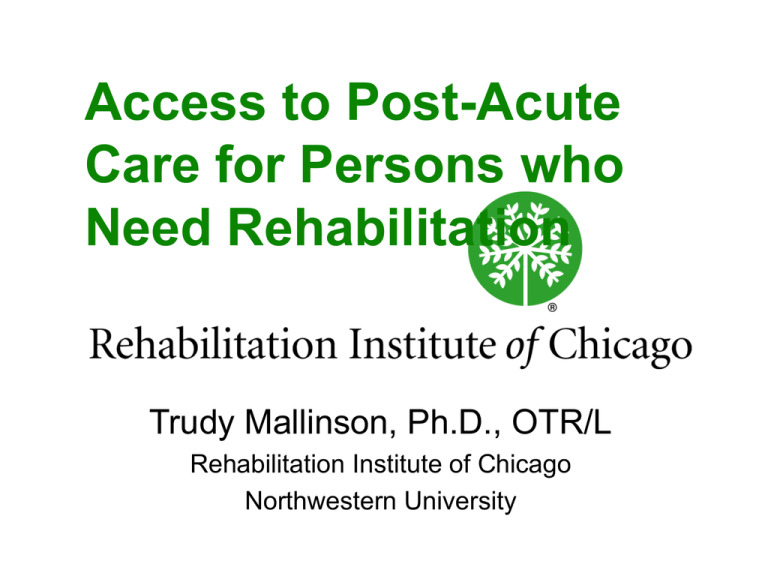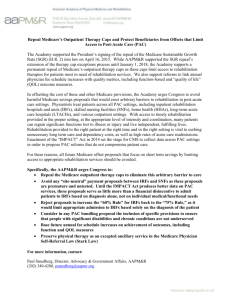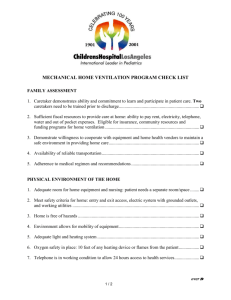Access to Post-Acute Care for Persons who Need Rehabilitation Trudy Mallinson, Ph.D., OTR/L
advertisement

Access to Post-Acute Care for Persons who Need Rehabilitation Trudy Mallinson, Ph.D., OTR/L Rehabilitation Institute of Chicago Northwestern University Post-Acute Care Providers that Provide Rehabilitation Services • • • • • Inpatient Rehabilitation Facilities (IRFs) Skilled Nursing Facilities (SNFs) Home Health Agencies (HHAs) Long-Term Care Hospitals (LTCHs) Other providers: Outpatient Comprehensive Outpatient Rehabilitation Facilities Adult Day Care Post-acute Care Rehab Settings • Medicare certification requirements vary by PAC setting e.g. IRFs (3 hrs therapy/day, 24hr medical supervision, 75% rule), SNFs (24hr nursing, limited MD, therapy hrs not specified) • However, much of the the rehabilitation care provided is similar across settings and, • Many patients could potentially be treated in more than one setting Medicare Expenditures • In the mid 1980s, care provided in post-acute care settings was considered a cost-effective alternative to extended hospital stays • By the early 1990s, care in post-acute care settings, including IRFs, SNFs, and HHAs had become the fastest growing area of the Medicare program Medicare spending for post-acute care has increased by more than $33 billion. Total Medicare payments from 1986 to 1996 by provider type (in billions) http://www.ahapolicyforum.org/trendwatch/twjune1999.asp Medicare Spending for Post-Acute Care, by setting, 1992-2001 HHA IPS (1997) HHA PPS (2000) SNF PPS (1998) IRF PPS (2002) LTCH PPS (2002) MedPAC, 2003 PAC PPS Comparison SNF HHC IRF LTCH Per Day Per 60-day episode Per discharge Per discharge MDS OASIS IRF PAI None 44 RUG-III groups 80 HHRGs 100 CMGS + tiers None (DRGs) None Fewer than 5 visits; high-cost outliers Short stay, deaths, transfers, highcost outliers None Unit of Payment Measure Product/Service Classification Product/Service boundaries Incentives MedPAC, 2002 Limit services received on daily basis Limit costs over entire stay, front load services, discharge early; Early Impact of PAC PPSs • SNFs Percentage of patients receiving extremely high levels of therapy decreased; percentage receiving moderate levels increased (White, 2003) • HHAs Significant reduction in number of agencies 1997 2000 (NAHC, 2001) but # of visits was much more severely reduced (Liu et al, 2003; McCall, 2003) Hospital-based HHAs made least reductions (McCall, 2003) Therapy visits as % of episode increased 9% in 1997 to 23% in 2001, (MedPAC, 2003) Early Impact IRF PPS • Continued decline Length-of-Stay Pre PPS in ALOS of Medicare patients in IRFs from • 15.4 days (RAND) in 1999 to 13.2 in 2002 (eRehabData). 30 25 Days 20 15 10 5 0 1992 1993 1994 1995 1996 1997 UDSmr reports, Am J PM&R, 1996 - 2002 1998 1999 Early Impact the IRF PPS • PPS increases pressure to reduce LOS CMS publishes average CMGt LOS (for purposes of calculating short stay patients) These LOS appear to have been interpreted as the upper limit on LOS ALOS for CMG 0114 (Severe stroke, no comorbidities) 2002 Average LOS (2002) = 22.3 days Published (1999) Transfer LOS = 33 days Based on eRehabData discharges, 2002 (n=2,157) Function at discharge trends down with LOS (2002-Q1 2004) LOS and FIM Motor at Discharge - Medicare Only 58.5 13.8 13.6 58 57.5 13.2 57 13 12.8 56.5 12.6 56 12.4 55.5 12.2 55 12 Q1 02 Q2 02 Q3 02 Q4 02 Q1 03 Q2 03 Q3 03 Q4 03 Q1 04 FIM Motor at Discharge eRehabData, 2004 Length of Stay Days FIM Motor Score 13.4 Discharge to community trends down All Medicare Discharges 77.4 2 points = clinically meaningful change (Deutsch, 2002; Buchanan; 2003) 88 87.5 77 76.8 87 76.6 76.4 86.5 76.2 76 86 75.8 75.6 85.5 2002 2003 Percent Discharge to Home eRehabData, 2004 Q1 2004 FIM at Discharge FIM Motor at Discharge Percent Discharge to Home 77.2 Discharge to institution trends up All Medicare Discharges 88 23 87.5 22.5 87 22 86.5 21.5 86 21 85.5 2002 2003 Percent Discharge to Institution eRehabData, 2004 Q1 2004 FIM at Discharge FIM Motor at Discharge Percent Discharge to Institution 23.5 2 points = clinically meaningful change (Deutsch, 2002; Buchanan; 2003) Greater impact on persons with chronic disabilities? Discharge to Institution - Medicare Only Discharge to Community - Medicare Only 40 80 35 30 60 Percent Percent 70 50 25 20 15 10 40 5 30 0 STROKE HIP FRACTURE 2002 eRehabData, 2004 2003 Q1 2004 ALL STROKE HIP FRACTURE 2002 2003 Q1 2004 ALL Does this reflect a change in trend? All Medicare Discharges 100 77.4 14 88 10 90 8 85 6 87.5 77 76.8 87 76.6 76.4 86.5 76.2 76 86 FIM Motor at Discharge 12 95 Percent Discharge to Home 77.2 75.8 80 4 75.6 85.5 2002 75 2 70 Percent Discharge to Home 0 1993 1994 1995 1996 1997 1998 Q1 2004 FIM at Discharge All Medicare Discharges 1999 DSCINT FIMDSC UDSmr reports, Am J PM&R, 1996 - 2002 Percent Discharge to Institution 23.5 DSCCOMM 88 23 87.5 22.5 87 22 86.5 21.5 86 21 85.5 2002 2003 Percent Discharge to Institution eRehabData, 2004 Q1 2004 FIM at Discharge FIM Motor at Discharge 1992 2003 Post-acute Care PPS • Under PPS, each PAC setting has a unique method of reimbursement • Creates non-neutral incentives for access and service provision. For example, the inpatient rehabilitation system (IRF PPS), a fixed per episode payment, creates incentives to reduce length-of-stay while the skilled nursing system (SNF PPS), a fixed per diem rate, creates incentives to reduce daily costs but not length-of-stay. Substitutability of Settings • Lack of clear clinical guidelines about which patients are most appropriately cared for in which PAC setting • Differing reimbursements may have made it advantageous for providers to admit and/or transfer patients within the PAC settings of their own organization, regardless of patient need. (MedPAC, 2003) Patterns of PAC Use • In addition, pre-PPS, 19-22% of all PAC patients receive care in 2 or more PAC settings consecutively (Gage, 1999). • Almost nothing is known about: patterns of PAC use across settings the costs associated with particular patterns how providers have altered patterns of PAC use in response to changing financial incentives Issues to Understand • Defining Access to PAC Who gets admitted Timing, intensity and duration of service (within IRF) Multiple PAC use within an episode of care Use of non-traditional, extender settings Issues to Understand • Provider Responses to PPS Tightening admission criteria to restrict access to severe or unpredictable patients; Restricting services daily, during the episode, or by reduced length-of-stay; Unbundling of services i.e. substituting PAC “extender” services such as day rehab for the later portion of care; Increasing use of LTCH and safety net hospitals as sites of rehabilitation; Increasing use of multiple components of the PAC continuum in a single episode of care e.g. SNF to IRF to HHC Issues to understand • Access to post-acute care is associated with: Patient factors: Diagnosis, functional status, social support, age Market (facility) factors: Geographic region, supply and ownership of facilities and, managed care penetration Early Impact of IRF-PPS • NIDRR HSR DRRP on Medical Rehabilitation - 5 year study, H133A030807 • Aim 1: Organization of Med. Rehabilitation Tom Prince, Elizabeth Durkin • Aim 2: Access To Medical Rehabilitation Trudy Mallinson, Larry Manheim • Aim 3: Patient Outcomes Allen Heinemann, Debbie Dobrez • Aim 4: Comorbidities Debbie Dobrez, Anne Deutsch NIDRR HSR DRRP • Aim 1 - Organization • Examine closings, mergers, • • • acquisitions Impact of market factors on restructuring Impact of IRF characteristics (unit or freestanding, forprofit status etc) on restructuring How responses to pressures are made (qualitative) • Aim 2 - Access • Examine changes in type • • and severity of patients admitted to IRFs Examine changes in PAC use (across episode) Effects greater for IRFs that are NFP, integrated with hospital, high pre-PPS costs relative to expected PPS revenues Available Databases for IRF • Medicare Provider of Service File Hospital Cost Reports Beneficiary Files • Proprietary eRehabData UDSmr Other issues impacting access to IRFS • LMRPs (Local Medical Review Policies) Now LCDs, developed and enforced by Fiscal Intermediaries (FIs) • 75% rule Previously not enforced, many facilities do not currently comply • Both of these will have a far greater impact on access to IRFs than PPS Longer-term issues • What rehab is (black box), for whom rehab is effective Confounds issues of access because can’t define who will do best in particular PAC settings • Do patient outcomes vary across post acute care settings and what are the costs associated with the outcomes? • What level of integration across the PAC-LTC continuum is needed to facilitate the most appropriate treatment decisions? What is NIDRR? • National Institute of Disability and • • Rehabilitation Research Organizationally located within the Office of Special Education Resources within the Department of Education Variety of funding mechanisms Field initiated, Centers - Research and Training, Engineering and Research, Fellowships Acknowledgments • Health Services Research – Disability and Rehabilitation Research Project on Medical Rehabilitation (H133A030807) The End







